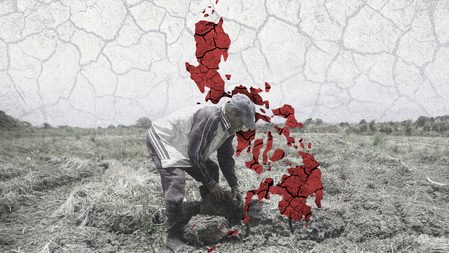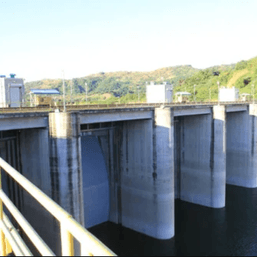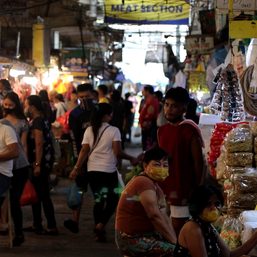SUMMARY
This is AI generated summarization, which may have errors. For context, always refer to the full article.
![[Vantage Point] When sugar turns sour: End users agonize from high prices](https://www.rappler.com/tachyon/2024/02/tl-sugar-turns-sour-February-6-2024.jpg)
Local bakers are again facing a recurring dilemma: should they increase the prices of their bread products or substantially cut their production?
Rodolfo Santos of Cuenca, Batangas, finds the latter option more palatable. Increasing the price of bread could only result to poor sales. With the price of sugar hitting the roof in recent months, scores of bakers are struggling to keep their noses above water as they suffer from higher costs of fuel and flour.
But for many other small neighborhood bakers, the streaking uptick in the price of sugar was the final nail on the coffin. Many of them are closing shop for good.
Compared to the previous year’s level, global sugar production in the 2023-2024 season will likely suffer a 2% decline, according to the United Nations Food and Agriculture Organization. This translates to a loss of about 3.5 million metric tons (3.8 million US tons), said FAO global commodities market researcher Fabio Palmeri. With sugar being used increasingly for biofuels like ethanol, global reserves of sugar are at their lowest since 2009.
Partly to blame as well for the increase in sugar prices is El Niño, a singularity in nature that alters global weather patterns. It spawns severe weather conditions ranging from drought to flooding.
Sugar is now trading at its highest prices since 2011 because of diminishing global supplies, triggered by absurd dry weather in India and Thailand, the world’s second and third-largest exporters, respectively. This is just the latest hit for developing nations, the Philippines included, which are already coping with shortages in staples like rice which have added to food inflation.
Government records show that local food inflation averaged 8% for the full year 2023, higher than the 6.1% recorded in 2022. Top contributors to food inflation in 2023 were rice (0.7 ppt); vegetables, tubers, plantains, cooking bananas, and pulses (0.5 percent); and fish and other seafood (0.4 ppt). In October 2023, sugar, confectionery, and desserts had an inflation rate of 4.2%, up from 10.0% in September 2023
For the 2022-2023 crop year, the Philippines was able to procure 1.94 million metric tons, while the supply of refined sugar and molasses only amounted to around 1.4 million metric tons and one million metric tons, respectively.

There has also been a noted shortage in the supply of sugar in the domestic market due to poor harvest for the 2021-2022 crop year, leading to the price increase of the commodity amidst suspicions of hoarding and smuggling committed by unscrupulous traders.

During the 2022-2023 crop year, refined sugar in the Philippines was being sold at P105, a substantial increase from the prevailing retail price in the 2020-2021 crop year, which was about P54.5 per kilo.
Recall that the United Sugar Producers Federation (Unifed) President Manuel Lamata, insisted then that unspecified traders are engaged in “manipulation and hoarding.” He even claimed that “there is no shortage at all.”
Why are prices increasing?
Alleged as a key cause of the Philippine sugar crisis was state-sponsored sugar smuggling. On February 21, 2023, Senator Risa Hontiveros filed Senate Resolution No. 497 and alleged before the Senate Blue Ribbon Committee that Sugar Order No. 6 of the Sugar Regulatory Administration (SRA) permitted the smuggling of 440,000 metric tons of sugar by and in favor of only three importers under terms that are contrary to law.
The average wholesale price of refined sugar remained relatively stable between 2018 and 2021, ranging from P2,100 to P2,500 per 50-kilo bag. SRA records show that in February 2023, the average wholesale price of refined sugar surged to P4,559.55 per 50-kilo bag. This was a marked increase compared to the same month in the previous year, where the price stood at an average of P2,981.25. Even so, the peak domestic price in 2023 exceeded the global market rates.
in May 2023, sugar being sold in local groceries reached a high of P136 per kilo. The same price uptick awaits bakeries, small eateries, and household consumers, due to poor regulation and a looming bad-crop year. Filipino consumers need to brace themselves first for high prices and then a sugar slump because domestic raw sugar production is predicted to hit a record 24-year low.
The Philippines is not likely to meet its sugar harvest goal or he current crop year. A statement released by SRA Administrator Pablo Luis S. Azcona said that harvest is anticipated to fall short of the initial target of 1.85 million metric tons, set prior to the commencement of the milling season.
While other sugar-producing countries have also trimmed their production estimates, the challenge for the Philippine sugar industry is compounded by weak regulation and virtual monopolies. Small-scale sugar farmers continue to grapple with financial challenges, thanks to another year of bad harvest and weak market regulation.
It should also be noted that weather disturbances directly impact on Philippine sugar production. Because of El Nino, there are fewer areas in the country where sugarcane is planted.
At the backdrop of a global price hike and a landscape dominated by monopolies, sugar prices in the Philippines remain inflated and much higher than the global average. Profits from domestic sugar production, however, are failing to trickle down to Filipino small-scale farmers. This imbalance leaves farmers, their families, and consumers bearing the brunt of soaring retail prices.
With the nation contending with escalating food inflation rates, urgent calls for sustainable, long-term solutions echo across the sector.
Time to abolish SRA?
For some industry players, the SRA is the “problem” and not the “solution.”
On September 21, 2022, Manila 6th District Representative Benny Abante Jr. filed House Bill No. 5081 which seeks to abolish the agency. The bill explains that the SRA “has not helped find any solution” to the looming food crisis triggered by a “problematic sugar industry,” with the problem being exacerbated the “incompetence and corruption that is prevalent in the SRA.”
As a matter of fact, Republic Act (R.A) 8178 or the Agricultural Tariffication Act of 1996 has already done away with quantitative restrictions on the importation of all agricultural products, except rice.
Unfortunately, the law is still to be implemented. The SRA continues to put a clamp on sugar importation, while at the same time enforcing various regulations on the domestic sugar industry, including restrictions on the inter-island shipping of sugar and the mandatory sharing arrangement between sugar mills and sugarcane planters.
If these issues continue to remain unresolved, domestic sugarcane production will remain low and the country’s sugar industry will remain stagnant.
Structural problems
In a previous column, I laid out the premise that the Philippine sugar industry will remain besieged by these problems unless the government exercises political will to zero in on solving structural problems afflicting the industry for so long.
Select agricultural sectors are protected by tariffs. If the tariff is in place, then there is no need for quotas, as the tariff carries the burden to protect the sector. Imports should be open to all and any importing business entities.
Under the ASEAN Free Trade Agreement, quotas must be abandoned once a commodity has had a tariff applied.
If the government determines that quotas are essential, then these should be auctioned off in a up-front, on-line auction to ensure transparency and generate a revenue for the government. It should be noted, however, that the retention of quotas is highly undesirable and may be illegal as per the ASEAN agreement.
The revenues from collected tariffs should be directed to well-designed industry adjustment schemes, with the clear intention of reaching a tariff of 0% in ten years. Otherwise, how can the Philippines ever become an agricultural powerhouse exporting food if the production industries are protected by tariffs?
The SRA’s heavy-handed regulatory implementation has been a failed experiment. Domestic sugar prices continue to soar higher than import-parity pricing, and taint a completely uncompetitive industry with the scent of state-sponsored corruption.
The Agricultural Tarrification Act of 1996 (or Republic Act No. 8178) eliminated quantitative restrictions on the importation of agricultural products (except rice, which was tariffed much later in 2018) and replaced them with more transparent import tariffs. It’s time that R.A. 8178 is respected and not mutilated which was what happened to the sugar industry with Executive Order No. 18, and reinforced under the Sugar Industry Development Act (SIDA) of 2015 (R.A. 10659), which created domestic and international trading restrictions implemented by the SRA.
Maintaining the SRA to ensure sugar delivery to fill the preferential US sugar quota allocation has been rendered irrelevant because the Philippines no longer has surplus sugar available for export. The government should now give priority to the Filipino stakeholders of the Philippine sugar industry. – Rappler.com
1 comment
How does this make you feel?

![[Vantage Point] Sugar mess gets messier](https://www.rappler.com/tachyon/2023/03/sugar-smuggling-march-21-2023.jpg?fit=449%2C449)
![[EDITORIAL] Apat na taon na lang Ginoong Marcos, ‘di na puwede ang papetiks-petiks](https://www.rappler.com/tachyon/2024/07/animated-bongbong-marcos-2024-sona-day-carousel.jpg?resize=257%2C257&crop=280px%2C0px%2C720px%2C720px)
![[In This Economy] Delulunomics: Kailan magiging upper-middle income country ang Pilipinas?](https://www.rappler.com/tachyon/2024/07/in-this-economy-upper-middle-income-country.jpg?resize=257%2C257&crop=421px%2C0px%2C1080px%2C1080px)

![[EDITORIAL] Marcos Year 2: Hilong-talilong](https://www.rappler.com/tachyon/2024/07/animated-bongbong-marcos-2nd-sona-carousel.jpg?resize=257%2C257&crop=136px%2C0px%2C720px%2C720px)
![[Newspoint] A fighting presence](https://www.rappler.com/tachyon/2024/07/thought-leaders-a-fighting-presence.jpg?resize=257%2C257&crop=441px%2C0px%2C1080px%2C1080px)
![[In This Economy] Runaway rice prices are making inflation higher than it needs to be](https://www.rappler.com/tachyon/2024/02/tl-rice-prices.jpg?resize=257%2C257&crop=560px%2C0px%2C720px%2C720px)
![[OPINION] The politics of rice – and managing perception](https://www.rappler.com/tachyon/2023/09/politics-rice-september-14-2023.jpg?resize=257%2C257&crop_strategy=attention)


Writer Val Villanueva stated: ” … the Philippine sugar industry will remain besieged by these problems unless the government exercises political will to zero in on solving structural problems afflicting the industry for so long.” This is the challenge to DA Secretary Francisco Tiu Laurel Jr. Perhaps these structural problems will persist because President Marcos Jr.’s political will is focused on something else.